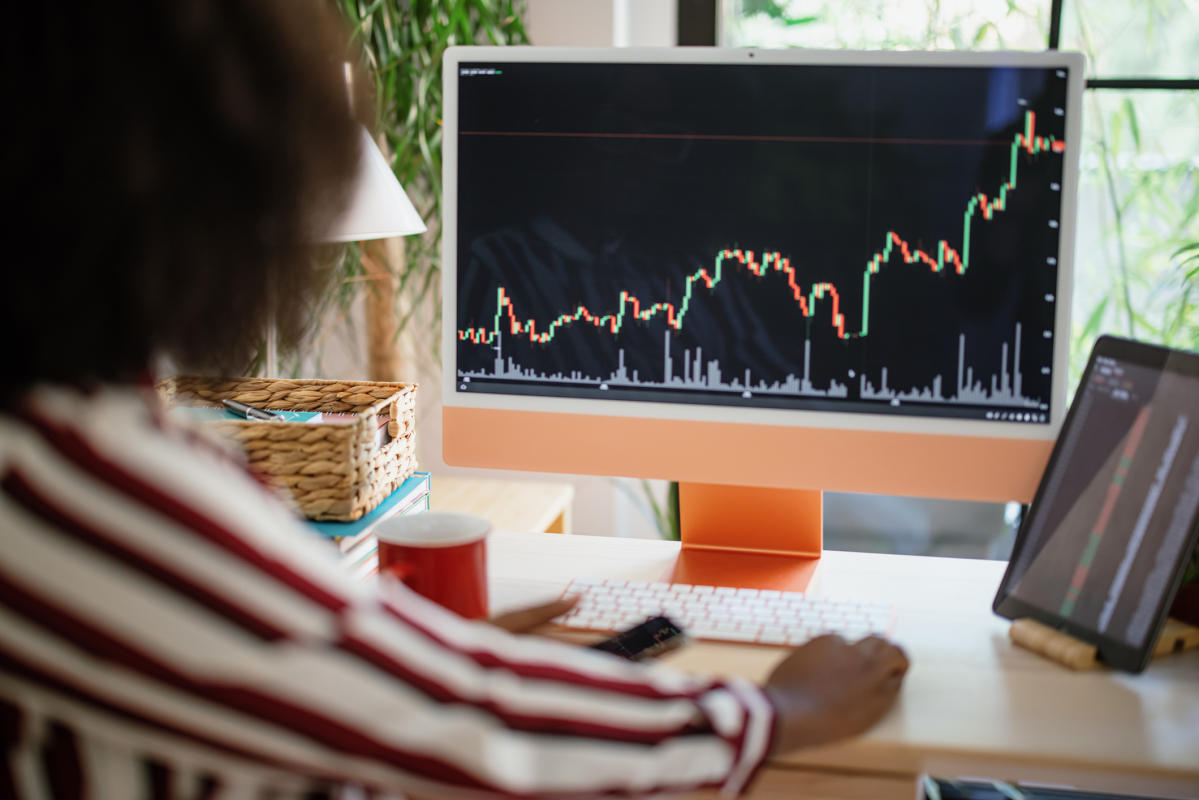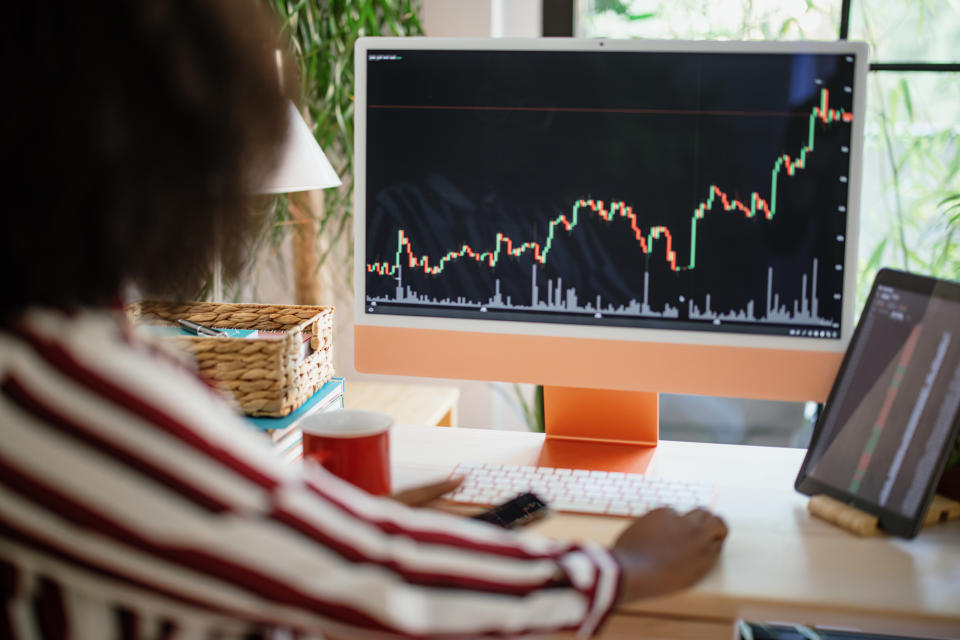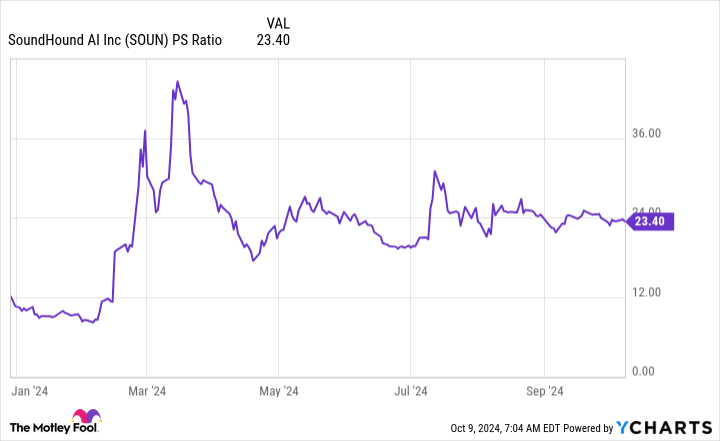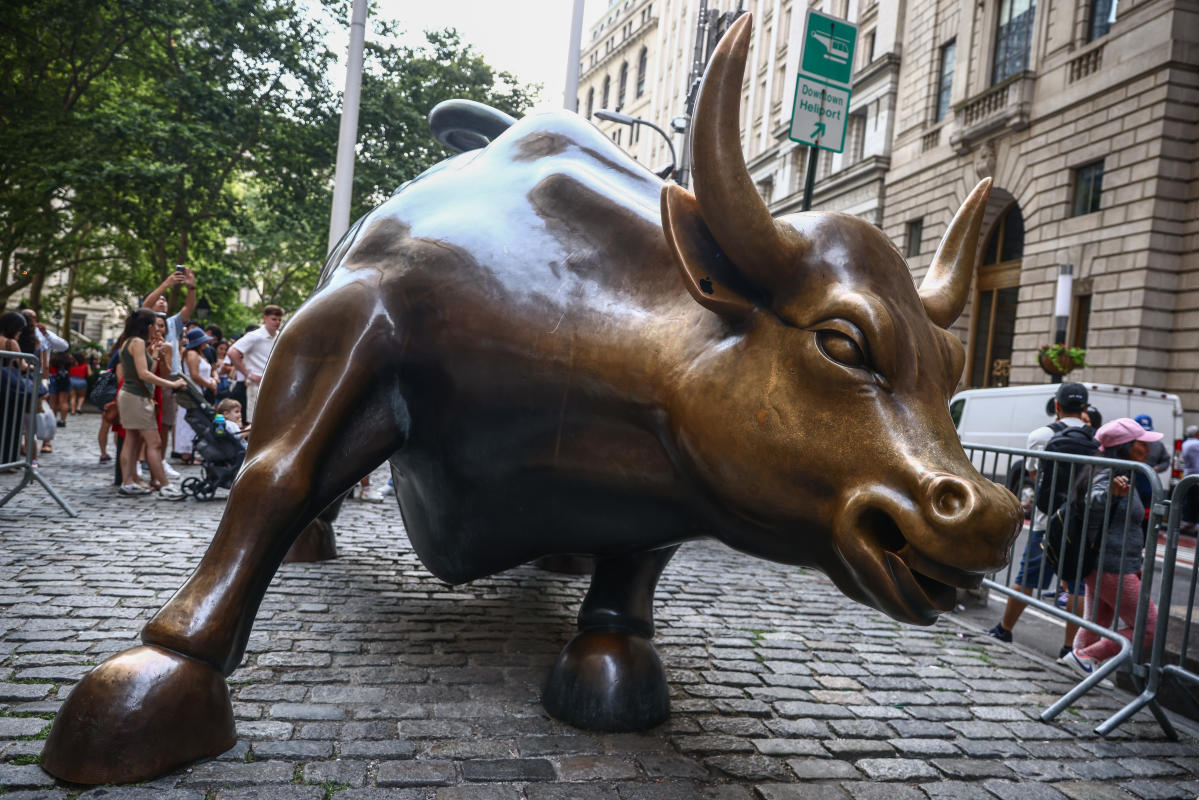CryptoCurrency
Billionaires Are Buying This Cryptocurrency That Could Soar 2,276%, According to Cathie Wood


The crypto market is preparing to soar, according to many famous investors. For example, ARK Invest founder Cathie Wood sees a bull-case price point of $1.5 million per Bitcoin (CRYPTO: BTC) in 2030. That would be a 2,276% return from today’s price, or a compound annual growth rate (CAGR) of 70% for six years.
That’s Wood’s most optimistic forecast, but even her bottom-end projections call for a $650,000 Bitcoin price by the end of this decade. Plenty of billionaires are building positions in this promising digital asset these days, hoping to capture the crypto’s long-term wealth creation at an early stage.
Let’s look at Cathie Wood’s rationale for these ultra-bullish price targets, and what these arguments could mean for us ordinary non-billionaires.
Wood’s bullish analysis
Wood doubled down on her million-dollar price targets for Bitcoin in a recent video interview with Peter Diamandis, founder of the XPRIZE Foundation, which promotes innovation. Her bullish argument centered around three core themes:
-
Thanks to Bitcoin’s planned scarcity with a hard cap of 21 million digital coins, it should eventually replace physical gold as a store of long-term value.
-
Institutional investors have not yet entered the market for the digital coin, despite the appearance of exchange-traded funds (ETFs) based on real-time crypto prices. When investment banks and financial advisors start taking the Bitcoin plunge, the whole industry should “fall in line pretty quick” with price-boosting results, Wood said.
-
Investors should see Bitcoin as an “insurance policy” against several financial risks like inflation, economic instability, or government overreach. These qualities should gain exposure and a following, especially in younger generations.
Together, she expects these pillars to support strong price growth.
“If we’re in the middle of the bull market, I think the next spur is going to be the platforms putting the spot Bitcoin ETF on it,” Wood said. “And I do think that will happen this year.”
Analyzing the bullish Bitcoin argument
I don’t see anything wrong with Wood’s logic.
The capped Bitcoin supply and gradual slowdown of new coin production are important parts of the cryptocurrency’s value system. The supply growth is already slower than the annual inflation of the gold supply from physical mining, so all that’s missing is a sustained increase in demand for the crypto. The good old law of supply and demand covers the rest of this argument.
Diamantis gave an anecdotal example of institutional resistance to Bitcoin assets, saying that a well-known financial advisor service refused to include spot Bitcoin ETFs in its portfolio services. That foot-dragging attitude could be the right idea if Bitcoin were destined to crash, burn, and go away. In any other scenario, the big banks should have to jump aboard the Bitcoin bandwagon eventually. The resulting cash infusions will push its price dramatically higher.
And the third bullish argument is just a question of consumer education. Bitcoin’s decentralized nature makes it difficult to impose government controls over this alternative financial system. I already explained how it is immune to traditional forces of supply-side inflation. The digital currency could be easier to use, but people are already leaning on Bitcoin in times of economic strife.
Bitcoin bulls should set realistic targets
Even so, I find it hard to peg a firm price target on Bitcoin — especially in the long term. Wood says that the institutional-investor dominoes should start to fall before the end of 2024, while the other bullish forces could have slower effects.
Keeping an eye on how quickly old-school bankers embrace the Bitcoin opportunity will provide a clearer map for what comes next. But the market isn’t quite there yet, so I’m holding my horses on the final analysis.
Will Bitcoin soar to $650,000 or even $1.5 million per coin in 2030? Maybe, but it doesn’t really matter. I expect it to gain value over time, most likely outperforming the S&P 500 (SNPINDEX: ^GSPC) stock market index in the long haul.
That’s good enough for me, and many investors with far deeper pockets would agree. The cryptocurrency, or one of the handy-dandy spot Bitcoin ETFs, should be a modest part of any diversified investment portfolio these days.
Don’t miss this second chance at a potentially lucrative opportunity
Ever feel like you missed the boat in buying the most successful stocks? Then you’ll want to hear this.
On rare occasions, our expert team of analysts issues a “Double Down” stock recommendation for companies that they think are about to pop. If you’re worried you’ve already missed your chance to invest, now is the best time to buy before it’s too late. And the numbers speak for themselves:
-
Amazon: if you invested $1,000 when we doubled down in 2010, you’d have $21,022!*
-
Apple: if you invested $1,000 when we doubled down in 2008, you’d have $43,329!*
-
Netflix: if you invested $1,000 when we doubled down in 2004, you’d have $393,839!*
Right now, we’re issuing “Double Down” alerts for three incredible companies, and there may not be another chance like this anytime soon.
*Stock Advisor returns as of October 7, 2024
Anders Bylund has positions in Bitcoin. The Motley Fool has positions in and recommends Bitcoin. The Motley Fool has a disclosure policy.
Billionaires Are Buying This Cryptocurrency That Could Soar 2,276%, According to Cathie Wood was originally published by The Motley Fool
CryptoCurrency
Could Buying SoundHound AI Now Be Like Buying Nvidia in 2023?

Nvidia‘s (NASDAQ: NVDA) stock has been an absolutely incredible performer recently. Since the start of 2023, it rose by more than 800%. Most investors would be thrilled to own a stock that delivered returns like that, but not every company has the potential. It requires a massive growth catalyst to justify such gains.
SoundHound AI (NASDAQ: SOUN) is one company that could have this potential. It’s a key player in one niche of the artificial intelligence (AI) sector, and has a massive backlog for its products.
SoundHound’s product is gaining momentum
SoundHound AI’s technology can parse human speech and perform various tasks based on what it hears. Among the ways it’s already being used most are in processing restaurant orders and improving digital assistants in vehicles, but its capabilities extend far beyond those two use cases.
In the automotive segment, SoundHound partnered with Stellantis; the giant automaker will integrate SoundHound’s tech into its vehicles across Europe and Japan. This will give people access to generative AI functions while they’re driving — an improvement from the voice assistants that are available on vehicles today. If SoundHound can win business with other automakers and break into other regions, this segment of its business alone could provide it with a huge amount of growth.
SoundHound also worked with several companies in the restaurant sector to automate telephone and drive-thru orders, which saves restaurants on wages. According to the company, these AI assistants actually outperform humans in terms of order speed and accuracy, so the customer doesn’t feel like the experience declined. Some of SoundHound’s restaurant customers, among them White Castle and Jersey Mike’s, are fairly big, but there’s serious room for it to grow if it can capture some of the largest fast-food businesses.
SoundHound AI could achieve even greater success if its solutions are utilized in new applications.
But is that potential enough to make its stock the next Nvidia?
Nvidia has one key advantage that SoundHound does not
In the second quarter, SoundHound generated $13.5 million in revenue, which was up 54% year over year. That’s quite small compared to other AI businesses.
However, the key figure investors should focus on is SoundHound’s backlog, which totals $723 million. This figure doubled from a year ago, showing that rising demand has outpaced SoundHound’s capability to integrate its product with its customers’ systems.
This is factoring into SoundHound’s current valuation, as Wall Street has high hopes for the company.
Trading at 23 times sales, SoundHound stock already carries a premium valuation. By contrast, Nvidia traded for around 15 times forward earnings at the start of 2023. That was a dirt-cheap price, and also a far cry from the forward earnings ratio of 47 it trades at today.
SoundHound already has a premium price tag, which detracts from its growth potential from here. But if it can mature into a business that generates $100 million in revenue per quarter, Nvidia-like performance for the stock is still possible.
If SoundHound achieved that and carried a valuation of 20 times sales, it would be worth $8 billion, up 370% from its market cap today. That would be a solid return, but still far less than what Nvidia produced.
SoundHound stock’s premium price tag may prevent it from delivering Nvidia-like returns from here, but that doesn’t mean it won’t be a great investment. However, it’s a bit of a long shot considering the niche use cases for its product and the company’s small size. It could make investors some serious money, but don’t expect Nvidia-like returns.
Should you invest $1,000 in SoundHound AI right now?
Before you buy stock in SoundHound AI, consider this:
The Motley Fool Stock Advisor analyst team just identified what they believe are the 10 best stocks for investors to buy now… and SoundHound AI wasn’t one of them. The 10 stocks that made the cut could produce monster returns in the coming years.
Consider when Nvidia made this list on April 15, 2005… if you invested $1,000 at the time of our recommendation, you’d have $826,130!*
Stock Advisor provides investors with an easy-to-follow blueprint for success, including guidance on building a portfolio, regular updates from analysts, and two new stock picks each month. The Stock Advisor service has more than quadrupled the return of S&P 500 since 2002*.
*Stock Advisor returns as of October 7, 2024
Keithen Drury has no position in any of the stocks mentioned. The Motley Fool has positions in and recommends Nvidia. The Motley Fool recommends Stellantis. The Motley Fool has a disclosure policy.
Could Buying SoundHound AI Now Be Like Buying Nvidia in 2023? was originally published by The Motley Fool
CryptoCurrency
China warns EU against separate EV price negotiations

BEIJING (Reuters) -China urged the European Union on Saturday not to conduct separate negotiations over the price of China-made electric vehicles sold in the EU, warning that this would “shake the foundations” of bilateral tariff negotiations.
“If the European side, while negotiating with China, conducts separate price commitment negotiations with some companies, it will shake the foundation and mutual trust of the negotiations … and be detrimental to advancing the overall negotiation process,” China’s Ministry of Commerce said in comments published on its website.
It didn’t cite any evidence for the EU carrying out these separate talks beyond saying there had been “relevant reports”.
The comments come days after Brussels rejected a Chinese proposal for EVs made in China to be sold within the bloc at a minimum price of 30,000 euros ($32,000), a move Beijing hoped would avert EU tariffs being imposed next month.
Various manufacturers including European-owned companies in China have authorized the China Chamber of Commerce for Machinery and Electronics to propose a price commitment plan that represents the overall position of the industry, the commerce ministry said.
“This is the basis for the current China-EU consultations,” it added.
(Reporting by Eduardo Baptista; Editing by William Mallard and David Holmes)
CryptoCurrency
The bull market is 2 years old. Here’s where Wall Street thinks stocks go next.

The bull market in the S&P 500 (^GSPC) began two years ago and is showing few signs of slowing.
Backed by the rise of artificial intelligence euphoria and a surprisingly resilient US economy, the S&P 500 has gained more than 60% in the past two years and is hovering near an all-time high.
Wall Street strategists who spoke with Yahoo Finance believe the bull can keep running wild. Barring any unexpected shocks, the path higher appears to be clear, with earnings growth expected to keep accelerating and the economy on seemingly solid footing as the Federal Reserve cuts interest rates.
A bull market for the S&P 500 was officially declared in June 2023 when the index rose 20% from its recent bear market low. History says this bull market still has legs. At two years, the bull market is well shy of the average run of 5.5 years. And the total return thus far, about 60%, is a far cry from the average 180% gain, per research from Carson Group chief market strategist Ryan Detrick.
In the past few weeks, several Wall Street equity strategists have made the case for the benchmark index to rise further into both year-end and into 2025, supported by accelerating earnings for the S&P 500.
“We continue to be surprised by the strength of market gains and decided yet again that something more than an incremental adjustment was warranted,” BMO Capital Markets chief investment strategist Brian Belski wrote in a September note when raising his year-end price target for the S&P 500 to a Street high of 6,100 from a previous target of 5,600.
On Oct. 4, Goldman Sachs boosted its year-end target to 6,000 and initiated a 12-month target of 6,300. Goldman Sachs chief equity strategist David Kostin did note, though, that already high valuations could limit the upside for how far the index can reach in 2025.
Risks to the rally
Strategists who spoke with Yahoo Finance agreed with Kostin that already stretched valuations present a challenge to how much higher stocks can go. Charles Schwab senior investment strategist Kevin Gordon noted that dating back to the mid-1960s, the only time valuations have been this stretched on a trailing 12-month price-to-earnings ratio were 2021 and the dot-com bubble of the late 1990s.
“This would tell you that the bull is much older or somewhat near the end of this life,” Gordon said.
But strategists often warn that a high valuation itself isn’t a proper tool for calling the end of a bull market. Stocks can trade at what are considered to be expensive valuations for longer than expected. What that does tell investors is that much of the good news that could push stocks higher might’ve already been priced in.
“If you look at what the market’s discounting right now, we’d say front and center, a big chunk of what’s being priced in is a soft landing sentiment,” Citi equity strategist Scott Chronert told Yahoo Finance.
Piper Sandler chief investment strategist Michael Kantrowitz noted that high valuations themselves aren’t why bull markets end. There needs to be a catalyst. He explained there are two common reasons market drawdowns happen: a spike in interest rates or a rise in the unemployment rate.
With inflation well off the boil of 2022 and the recent increase in unemployment stalling out, neither of the two downside catalysts are clearly in view.
There could, of course, be a surprise no one sees coming. But “it’s a little bit harder to see where the shock comes from,” Chronert said. “If things continue to play out incrementally, investors can handle a little bit of a change [to the economic narrative] here, a little bit of a change there … It’s when you get a more immediate unraveling, and it’s hard to really say that immediate unraveling is going to come.”
This sets the market up for a narrative shift. To Kantrowitz, the currently expensive valuations show that the bull market is likely moving from a macro-driven environment, where factors like inflation falling and other signs of economic resilience have pushed stocks higher, to one that is more based on the fundamentals.
“For this market to continue moving higher, and particularly to determine what stocks lead, it’s going to be all about earnings,” Kantrowitz said.
The bar for earnings remains high. Consensus estimates project earnings to grow nearly 10% in 2024 and almost 15% in 2025. The key for investors remains finding which sectors are seeing earnings growth accelerate rather than just staying steady.
And , according to Chronert, part of that story could come down to the two letters that defined the first part of the bull market: AI.
Chronert, who said his team is still a holder of the “Magnificent Seven” tech cohort, doesn’t doubt that the AI narrative will continue to manifest itself in the market. But after significant gains seen in those tech stocks over the past two years amid large earnings growth, focus may continue to shift to the broadening impact of AI on companies that aren’t making the AI chips or the cloud servers operating the new technology.
For AI to continue to have broader impact on the market and keep pushing earnings growth for the index above expectations, “you’ve got to have more companies delivering on the AI promise via margins [and] profitability metrics,” Chronert said.
He added, “It would be that sort of thesis that has to play out, and that’s going to take two to five years.”
Josh Schafer is a reporter for Yahoo Finance. Follow him on X @_joshschafer.
Click here for in-depth analysis of the latest stock market news and events moving stock prices
Read the latest financial and business news from Yahoo Finance
CryptoCurrency
Scroll lists on Binance, sparking debate over centralization concerns


Scroll’s Binance listing has sparked community debate, with critics raising concerns about centralization, while Scroll’s co-founder has highlighted global growth strategies.
CryptoCurrency
Cardano hosts first legally enforceable contract in Argentina


The milestone moment comes 10 months after the country legalized crypto for payments in commercial contracts last December.
CryptoCurrency
3 Reliable Dividend Stocks With Yields Above 5% That You Can Buy With Less Than $100 Right Now


There’s no wrong way to put your money to work on Wall Street, but some methods produce more reliable gains than others. If you’re looking for a relatively safe and easy way to grow the stream of income you’ll have to work with during your retirement years, buying dividend-paying stocks and holding them for long periods is a terrific option.
During the 50-year period that ended in 2023, dividend-paying stocks in the S&P 500 index returned 9.17% annually on average. That’s more than double the return produced by their non-dividend-paying cousins. During the same period, the average dividend non-payers in the benchmark index returned just 4.27% annually, according to Ned Davis Research and Hartford funds.
You don’t need to be rich to put your money to work for you. At the moment, shares of AT&T (NYSE: T), Hercules Capital (NYSE: HTGC), and Pfizer (NYSE: PFE) offer dividend yields of 5% or better, and you can buy a share of all three with less than $100. Adding them to a portfolio now gives you a good chance to outperform the market while they beef up your passive-income stream.
1. AT&T
AT&T lowered its dividend payout in 2022 to adjust for the sale of its unpredictable media assets. Now that it’s strictly a telecommunications business, the cash flows it uses to make dividend payments should be extra reliable. At recent prices, the stock offers a 5.2% dividend yield.
Traditional-wireline subscriptions are still shrinking, but this headwind is easily overcome by demand for services that run on its 5G network and a growing web of fiber-optic cables. In the second quarter, mobility-service revenue rose 3.4% year over year, and this isn’t the only operation driving growth.
The three-month period ended June 30 was the 18th consecutive quarter in which AT&T added over 200,000 new fiber-internet subscribers. Late last year, the company also launched a fixed-wireless service for folks who aren’t located next to fiber optic cables. As a result, Q2 consumer-broadband sales rose 7% year over year.
At $2.7 billion in Q2, consumer broadband is responsible for less than 10% of total revenue. AT&T is one of just three telecom companies with a nationwide 5G network, so investors can reasonably rely on its consumer-broadband business to drive growth for many years to come.
2. Hercules Capital
Hercules Capital is a business development company (BDC), which means it can avoid income taxes by giving nearly all of its earnings to shareholders as a dividend payment. At recent prices, the stock’s regular distribution offers a big 8% yield.
Hercules also offers a supplemental dividend that it set at $0.32 per share this year. If next year’s supplemental dividend remains unchanged, investors who buy this stock at recent prices will receive a 9.7% yield.
Most BDCs originate relatively high-interest loans to established mid-sized businesses that already earn money. Hercules Capital takes a riskier approach to financing by engaging start-ups in the life science and technology industries before they have any recurring revenues to report.
In isolation, the bets Hercules makes are extremely risky. The potential payoffs are so large, though, that the company can report strong-earnings growth if just a fraction of its investments succeed.
Hercules has raised or maintained its regular distribution since 2010, and continued movement in the right direction seems likely. In the first half of 2024, the BDC reported $1.07 billion in total-gross funding, which was 28% more than the previous-year period.
3. Pfizer
Sales of Pfizer’s COVID-19 vaccine and antiviral treatment broke records regarding its rate of growth and decline. Sales of Comirnaty and Paxlovid shot up to a combined $56.7 billion in 2022. Less than a year and a half later, sales of the same two drugs collapsed to an annualized $1.8 billion.
Don’t let its recent ups and downs confuse you. Pfizer is a reliable dividend payer that has raised its payout every year since 2009. At recent prices, it offers a 5.7% yield that will be easier to predict now that sinking sales of its COVID-19 products are responsible for less than 3% of total revenue.
Pfizer’s dividend payout is supported by one of the largest catalogs of drugs with patent-protected market exclusivity. In the first half of 2024, a dozen of its products grew sales by a double-digit percentage compared to the previous year period.
One of the investments Pfizer made with its pandemic-related earnings haul was the $43 billion acquisition of cancer drug developer Seagen. The purchase gave Pfizer access to four commercial-stage treatments, including Padcev. In late 2023, Padcev became a chemotherapy-free option for newly diagnosed bladder cancer patients. As such, sales are expected to reach $8 billion annually by 2030.
Padcev is one of several blockbuster drugs that could help Pfizer continue its dividend-raising streak. Adding some shares to a diverse portfolio now seems like the right move.
Don’t miss this second chance at a potentially lucrative opportunity
Ever feel like you missed the boat in buying the most successful stocks? Then you’ll want to hear this.
On rare occasions, our expert team of analysts issues a “Double Down” stock recommendation for companies that they think are about to pop. If you’re worried you’ve already missed your chance to invest, now is the best time to buy before it’s too late. And the numbers speak for themselves:
-
Amazon: if you invested $1,000 when we doubled down in 2010, you’d have $21,022!*
-
Apple: if you invested $1,000 when we doubled down in 2008, you’d have $43,329!*
-
Netflix: if you invested $1,000 when we doubled down in 2004, you’d have $393,839!*
Right now, we’re issuing “Double Down” alerts for three incredible companies, and there may not be another chance like this anytime soon.
*Stock Advisor returns as of October 7, 2024
Cory Renauer has no position in any of the stocks mentioned. The Motley Fool has positions in and recommends Pfizer. The Motley Fool has a disclosure policy.
3 Reliable Dividend Stocks With Yields Above 5% That You Can Buy With Less Than $100 Right Now was originally published by The Motley Fool
-

 Science & Environment3 weeks ago
Science & Environment3 weeks agoHyperelastic gel is one of the stretchiest materials known to science
-

 Technology3 weeks ago
Technology3 weeks agoWould-be reality TV contestants ‘not looking real’
-

 Science & Environment3 weeks ago
Science & Environment3 weeks agoHow to unsnarl a tangle of threads, according to physics
-

 Science & Environment3 weeks ago
Science & Environment3 weeks ago‘Running of the bulls’ festival crowds move like charged particles
-

 Womens Workouts3 weeks ago
Womens Workouts3 weeks ago3 Day Full Body Women’s Dumbbell Only Workout
-

 Science & Environment3 weeks ago
Science & Environment3 weeks agoMaxwell’s demon charges quantum batteries inside of a quantum computer
-

 Science & Environment3 weeks ago
Science & Environment3 weeks agoLiquid crystals could improve quantum communication devices
-

 Science & Environment3 weeks ago
Science & Environment3 weeks agoQuantum ‘supersolid’ matter stirred using magnets
-

 Science & Environment3 weeks ago
Science & Environment3 weeks agoSunlight-trapping device can generate temperatures over 1000°C
-

 Science & Environment3 weeks ago
Science & Environment3 weeks agoITER: Is the world’s biggest fusion experiment dead after new delay to 2035?
-
News4 weeks ago
the pick of new debut fiction
-

 Science & Environment3 weeks ago
Science & Environment3 weeks agoHow to wrap your mind around the real multiverse
-

 Science & Environment3 weeks ago
Science & Environment3 weeks agoWhy this is a golden age for life to thrive across the universe
-

 Science & Environment3 weeks ago
Science & Environment3 weeks agoNerve fibres in the brain could generate quantum entanglement
-

 News3 weeks ago
News3 weeks agoOur millionaire neighbour blocks us from using public footpath & screams at us in street.. it’s like living in a WARZONE – WordupNews
-

 Science & Environment3 weeks ago
Science & Environment3 weeks agoQuantum forces used to automatically assemble tiny device
-

 Technology2 weeks ago
Technology2 weeks agoIs sharing your smartphone PIN part of a healthy relationship?
-

 Science & Environment2 weeks ago
Science & Environment2 weeks agoX-rays reveal half-billion-year-old insect ancestor
-

 Science & Environment3 weeks ago
Science & Environment3 weeks agoA slight curve helps rocks make the biggest splash
-

 Science & Environment3 weeks ago
Science & Environment3 weeks agoTime travel sci-fi novel is a rip-roaringly good thought experiment
-

 Science & Environment3 weeks ago
Science & Environment3 weeks agoLaser helps turn an electron into a coil of mass and charge
-

 Science & Environment3 weeks ago
Science & Environment3 weeks agoPhysicists are grappling with their own reproducibility crisis
-
Business2 weeks ago
Eurosceptic Andrej Babiš eyes return to power in Czech Republic
-

 Science & Environment3 weeks ago
Science & Environment3 weeks agoNuclear fusion experiment overcomes two key operating hurdles
-

 News4 weeks ago
News4 weeks ago▶️ Hamas in the West Bank: Rising Support and Deadly Attacks You Might Not Know About
-

 News3 weeks ago
News3 weeks agoYou’re a Hypocrite, And So Am I
-

 Sport3 weeks ago
Sport3 weeks agoJoshua vs Dubois: Chris Eubank Jr says ‘AJ’ could beat Tyson Fury and any other heavyweight in the world
-

 Science & Environment4 weeks ago
Science & Environment4 weeks agoCaroline Ellison aims to duck prison sentence for role in FTX collapse
-

 News3 weeks ago
News3 weeks ago▶️ Media Bias: How They Spin Attack on Hezbollah and Ignore the Reality
-

 Science & Environment3 weeks ago
Science & Environment3 weeks agoA new kind of experiment at the Large Hadron Collider could unravel quantum reality
-
Business2 weeks ago
Should London’s tax exiles head for Spain, Italy . . . or Wales?
-

 Technology2 weeks ago
Technology2 weeks ago‘From a toaster to a server’: UK startup promises 5x ‘speed up without changing a line of code’ as it plans to take on Nvidia, AMD in the generative AI battlefield
-

 Football2 weeks ago
Football2 weeks agoFootball Focus: Martin Keown on Liverpool’s Alisson Becker
-

 Science & Environment3 weeks ago
Science & Environment3 weeks agoRethinking space and time could let us do away with dark matter
-

 News4 weeks ago
News4 weeks agoNew investigation ordered into ‘doorstep murder’ of Alistair Wilson
-
News3 weeks ago
The Project Censored Newsletter – May 2024
-

 Technology2 weeks ago
Technology2 weeks agoQuantum computers may work better when they ignore causality
-

 MMA2 weeks ago
MMA2 weeks agoConor McGregor challenges ‘woeful’ Belal Muhammad, tells Ilia Topuria it’s ‘on sight’
-

 Sport2 weeks ago
Sport2 weeks agoWatch UFC star deliver ‘one of the most brutal knockouts ever’ that left opponent laid spark out on the canvas
-

 News3 weeks ago
News3 weeks agoIsrael strikes Lebanese targets as Hizbollah chief warns of ‘red lines’ crossed
-

 Science & Environment3 weeks ago
Science & Environment3 weeks agoA tale of two mysteries: ghostly neutrinos and the proton decay puzzle
-

 Science & Environment3 weeks ago
Science & Environment3 weeks agoFuture of fusion: How the UK’s JET reactor paved the way for ITER
-

 Technology2 weeks ago
Technology2 weeks agoGet ready for Meta Connect
-
Business2 weeks ago
Ukraine faces its darkest hour
-

 Health & fitness3 weeks ago
Health & fitness3 weeks agoThe secret to a six pack – and how to keep your washboard abs in 2022
-

 Technology4 weeks ago
Technology4 weeks agoThe ‘superfood’ taking over fields in northern India
-

 Science & Environment3 weeks ago
Science & Environment3 weeks agoUK spurns European invitation to join ITER nuclear fusion project
-

 Science & Environment3 weeks ago
Science & Environment3 weeks agoWhy we need to invoke philosophy to judge bizarre concepts in science
-

 News3 weeks ago
News3 weeks agoWhy Is Everyone Excited About These Smart Insoles?
-

 Health & fitness2 weeks ago
Health & fitness2 weeks agoThe 7 lifestyle habits you can stop now for a slimmer face by next week
-

 CryptoCurrency3 weeks ago
CryptoCurrency3 weeks agoCardano founder to meet Argentina president Javier Milei
-
Politics3 weeks ago
UK consumer confidence falls sharply amid fears of ‘painful’ budget | Economics
-

 MMA3 weeks ago
MMA3 weeks agoRankings Show: Is Umar Nurmagomedov a lock to become UFC champion?
-

 Science & Environment3 weeks ago
Science & Environment3 weeks agoMeet the world's first female male model | 7.30
-

 News3 weeks ago
News3 weeks agoFour dead & 18 injured in horror mass shooting with victims ‘caught in crossfire’ as cops hunt multiple gunmen
-

 Womens Workouts3 weeks ago
Womens Workouts3 weeks ago3 Day Full Body Toning Workout for Women
-

 Technology3 weeks ago
Technology3 weeks agoRobo-tuna reveals how foldable fins help the speedy fish manoeuvre
-

 Science & Environment3 weeks ago
Science & Environment3 weeks agoPhysicists have worked out how to melt any material
-

 Health & fitness3 weeks ago
Health & fitness3 weeks agoThe maps that could hold the secret to curing cancer
-

 Science & Environment3 weeks ago
Science & Environment3 weeks agoBeing in two places at once could make a quantum battery charge faster
-

 News4 weeks ago
News4 weeks agoHow FedEx CEO Raj Subramaniam Is Adapting to a Post-Pandemic Economy
-

 CryptoCurrency3 weeks ago
CryptoCurrency3 weeks agoDecentraland X account hacked, phishing scam targets MANA airdrop
-

 CryptoCurrency3 weeks ago
CryptoCurrency3 weeks agoLow users, sex predators kill Korean metaverses, 3AC sues Terra: Asia Express
-

 Womens Workouts3 weeks ago
Womens Workouts3 weeks agoBest Exercises if You Want to Build a Great Physique
-

 Womens Workouts3 weeks ago
Womens Workouts3 weeks agoEverything a Beginner Needs to Know About Squatting
-

 TV3 weeks ago
TV3 weeks agoCNN TÜRK – 🔴 Canlı Yayın ᴴᴰ – Canlı TV izle
-

 Science & Environment3 weeks ago
Science & Environment3 weeks agoCNN TÜRK – 🔴 Canlı Yayın ᴴᴰ – Canlı TV izle
-

 Servers computers2 weeks ago
Servers computers2 weeks agoWhat are the benefits of Blade servers compared to rack servers?
-

 Technology2 weeks ago
Technology2 weeks agoThe best robot vacuum cleaners of 2024
-

 News3 weeks ago
News3 weeks agoChurch same-sex split affecting bishop appointments
-

 Politics3 weeks ago
Politics3 weeks agoTrump says he will meet with Indian Prime Minister Narendra Modi next week
-

 Sport3 weeks ago
Sport3 weeks agoUFC Edmonton fight card revealed, including Brandon Moreno vs. Amir Albazi headliner
-

 CryptoCurrency3 weeks ago
CryptoCurrency3 weeks agoEthereum is a 'contrarian bet' into 2025, says Bitwise exec
-

 Science & Environment3 weeks ago
Science & Environment3 weeks agoHow one theory ties together everything we know about the universe
-
Business4 weeks ago
JPMorgan in talks to take over Apple credit card from Goldman Sachs
-

 Science & Environment3 weeks ago
Science & Environment3 weeks agoQuantum time travel: The experiment to ‘send a particle into the past’
-

 Science & Environment3 weeks ago
Science & Environment3 weeks agoTiny magnet could help measure gravity on the quantum scale
-

 Science & Environment3 weeks ago
Science & Environment3 weeks agoMost accurate clock ever can tick for 40 billion years without error
-

 CryptoCurrency3 weeks ago
CryptoCurrency3 weeks agoBitcoin miners steamrolled after electricity thefts, exchange ‘closure’ scam: Asia Express
-

 CryptoCurrency3 weeks ago
CryptoCurrency3 weeks agoDorsey’s ‘marketplace of algorithms’ could fix social media… so why hasn’t it?
-

 CryptoCurrency3 weeks ago
CryptoCurrency3 weeks agoDZ Bank partners with Boerse Stuttgart for crypto trading
-

 CryptoCurrency3 weeks ago
CryptoCurrency3 weeks agoBitcoin bulls target $64K BTC price hurdle as US stocks eye new record
-

 CryptoCurrency3 weeks ago
CryptoCurrency3 weeks agoBlockdaemon mulls 2026 IPO: Report
-
Business3 weeks ago
Thames Water seeks extension on debt terms to avoid renationalisation
-
Politics3 weeks ago
‘Appalling’ rows over Sue Gray must stop, senior ministers say | Sue Gray
-

 CryptoCurrency3 weeks ago
CryptoCurrency3 weeks agoCoinbase’s cbBTC surges to third-largest wrapped BTC token in just one week
-

 News2 weeks ago
News2 weeks agoUS Newspapers Diluting Democratic Discourse with Political Bias
-

 Technology2 weeks ago
Technology2 weeks agoMicrophone made of atom-thick graphene could be used in smartphones
-

 Technology3 weeks ago
Technology3 weeks agoiPhone 15 Pro Max Camera Review: Depth and Reach
-

 News3 weeks ago
News3 weeks agoBrian Tyree Henry on voicing young Megatron, his love for villain roles
-

 Science & Environment3 weeks ago
Science & Environment3 weeks agoHow do you recycle a nuclear fusion reactor? We’re about to find out
-

 CryptoCurrency3 weeks ago
CryptoCurrency3 weeks agoRedStone integrates first oracle price feeds on TON blockchain
-

 CryptoCurrency3 weeks ago
CryptoCurrency3 weeks ago‘No matter how bad it gets, there’s a lot going on with NFTs’: 24 Hours of Art, NFT Creator
-
Business3 weeks ago
How Labour donor’s largesse tarnished government’s squeaky clean image
-

 News3 weeks ago
News3 weeks agoBrian Tyree Henry on voicing young Megatron, his love for villain roles
-

 Travel3 weeks ago
Travel3 weeks agoDelta signs codeshare agreement with SAS
-

 Politics2 weeks ago
Politics2 weeks agoHope, finally? Keir Starmer’s first conference in power – podcast | News
-

 Technology2 weeks ago
Technology2 weeks agoUniversity examiners fail to spot ChatGPT answers in real-world test
-

 CryptoCurrency3 weeks ago
CryptoCurrency3 weeks agoLouisiana takes first crypto payment over Bitcoin Lightning
-

 CryptoCurrency3 weeks ago
CryptoCurrency3 weeks agoCrypto scammers orchestrate massive hack on X but barely made $8K


You must be logged in to post a comment Login